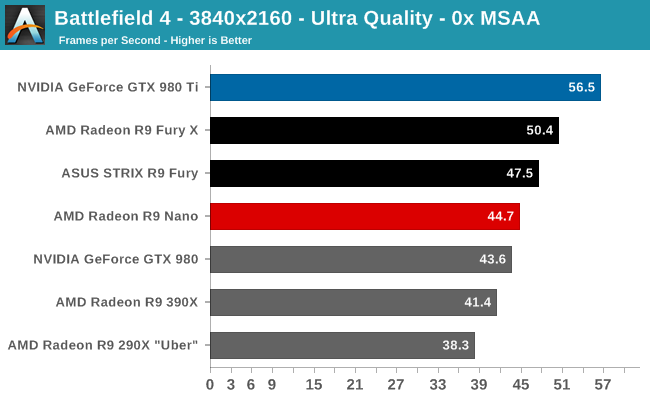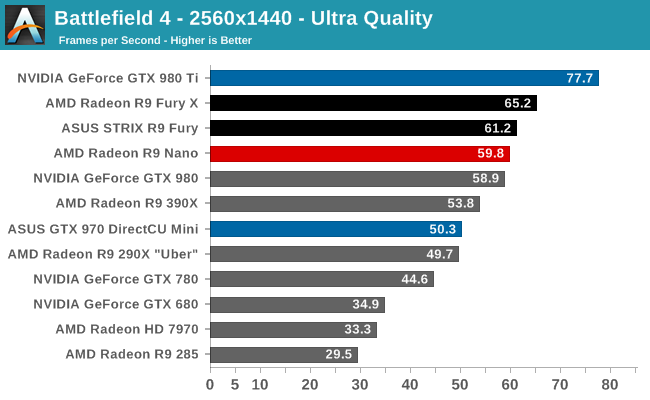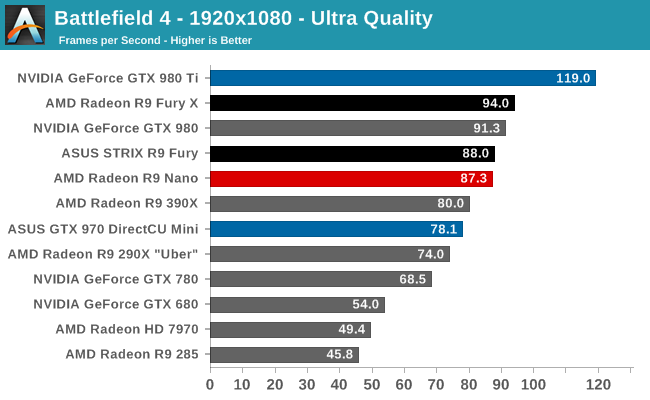The AMD Radeon R9 Nano Review: The Power of Size
by Ryan Smith on September 10, 2015 8:00 AM ESTBattlefield 4
Kicking off our benchmark suite is Battlefield 4, DICE’s 2013 multiplayer military shooter. After a rocky start, Battlefield 4 has since become a challenging game in its own right and a showcase title for low-level graphics APIs. As these benchmarks are from single player mode, based on our experiences our rule of thumb here is that multiplayer framerates will dip to half our single player framerates, which means a card needs to be able to average at least 60fps if it’s to be able to hold up in multiplayer.




Like the other Fiji cards, AMD is promoting the R9 Nano in part on its 4K capabilities. And while we disagree that this card is suitable for 4K gaming based on its sub-Fury performance, we’re including 4K results anyhow to serve as a point of comparison.
In any case Battlefield 4 is often a good indicator of general card performance, and for the R9 Nano this is no exception. What we find is that the R9 Nano trails the other Fury cards in all cases. However to our initial surprise, the R9 Nano sticks rather close to the R9 Fury. The petite powerhouse trails the R9 Fury by only 1-6%, which for the record is a smaller gap than we were expecting.
While the R9 Nano packs a full Fiji GPU, AMD has to pull back on clockspeeds to hit their power targets; in the case of Battlefield 4 this is an average clockspeed of just 879MHz at 2560x1440. Given this we had been expecting the R9 Nano to deliver around 85-90% of the performance of the R9 Fury (and about 80% of the R9 Fury X), based on the assumption that average clockspeeds would be closer to 800MHz. So the fact that the R9 Nano starts off as close to the R9 Fury as it does – even if it’s still trailing it – is a pleasant surprise.
Otherwise with performance still clearly occupying a position as a “3rd tier” Fiji card, I’m not sure if anything about these results should be surprising. On a price/performance basis AMD is not intending to be competitive with other $650 cards, so the R9 Fury X and GTX 980 Ti are of course on the top of the heap. What you get instead is a card that delivers around 90% of R9 Fury X’s performance in BF4 with much less power consumption.
Moving on, compared to the lower power and smaller cards, the R9 Nano is as expected a clean sweep. Demonstrating the virtues of a wide and lower clocked processor’s ability to deliver strong performance without requiring extreme power, everything from the R9 285 to the GTX 980 trails the R9 Nano here. Compared to the GTX 970 Mini in particular, the R9 Nano is 12-26% faster depending on the resolution.
The one potential problem here for the R9 Nano is the GTX 980. Though not a Mini-ITX card, the GTX 980’s power consumption is going to be fairly close to the R9 Nano’s, definitely more so than GTX 970’s. From a power efficiency standpoint it’s the GTX 980 that poses the greatest challenge to the R9 Nano, and while it’s ahead of the GTX 980 in this case at 2560x1440 and higher, it’s a sign that AMD should be worried about what could happen if an NVIDIA partner produced a Mini-ITX GTX 980.










284 Comments
View All Comments
gw74 - Friday, September 11, 2015 - link
Everything you say here is refuted by my previous comment.slickr - Saturday, September 12, 2015 - link
LOL. Either you are one of the biggest dumbasses out there or a shill yourself. To believe it was a "honest mistake" is like believing the earth is made out of cheese.They had at least 2 months to fix it and to rectify it, did they not read any of the hundred of reviews? They tried to cover it up and it was only when average CONSUMERS started noticing it and testing it that it was found out it had been a major fraud.
gw74 - Saturday, September 12, 2015 - link
insulting me, setting up a false dichotomy and a false analogy will not help you.They did not realise there had been an error during those 2 months, and none of the reviews mentioned it, because it does not noticeably affect performance except in certain SLI / 4K low framerate edge cases. It was only when until users starting reporting it in mid Jan. They had meetings between marketing and engineering then released a statement to PCPer on 24th Jan.
Oxford Guy - Tuesday, September 15, 2015 - link
Nvidia continued to lie to the public on its website by stating that the 970 has 224 GB/s, long after Anandtech's Correcting the Specs article was published — which made it clear enough that the card can't reach that number. Quit shilling.Alexvrb - Saturday, September 12, 2015 - link
Err, uh, the engineers only communicate in binary! The translator was sick that week! Locusts! It wasn't their fault!!Reality: "Well technically it has 4GB on there so we'll just... leave that detail out... they won't notice for months anyway. Then we'll apologize and a bunch of fanboys will defend us till the bitter end anyway."
If AMD had pulled a stunt like that they would have been raked through the coals till there were only ashes.
gw74 - Saturday, September 12, 2015 - link
no. that is not "reality". That is speculation.bigboxes - Thursday, September 10, 2015 - link
Utter nonsense. Nvidia knew damn well that they had a technical and marketing issue and lied through their teeth. Misleading reviewers, customers and the general tech community. It eventually came out and they went into full damage control. And before you say it, I bought an MSI GTX 970 Gaming 4G card after all this went down. I'm happy with this card, but it is what it is.gw74 - Friday, September 11, 2015 - link
you forgot to include evidence of them lying, or a reason for why they would lie.Oxford Guy - Friday, September 11, 2015 - link
It's called reality, dude.gw74 - Friday, September 11, 2015 - link
meaningless